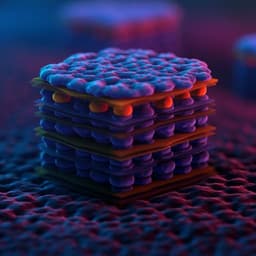
Engineering and Technology
Layer-dependent Schottky contact at van der Waals interfaces: V-doped WSe₂ on graphene
S. Stolz, A. Kozhakhmetov, et al.
This exciting research by Samuel Stolz and colleagues delves into the enhancements provided by van der Waals semimetals when interfaced with 2D semiconductors, revealing how heavily doped WSe₂ exhibits unique charge dynamics as thickness varies, influencing contact resistance significantly.
~3 min • Beginner • English
Introduction
Layered two-dimensional (2D) transition metal dichalcogenide (TMDC) semiconductors are promising beyond silicon materials owing to their attractive optoelectronic properties and weak inter-layer coupling that overcomes vital engineering challenges of bulk materials regarding heteromaterial integration and miniaturization. Among potential applications for 2D-TMDCs are stacked nanosheet field effect transistors, lateral heterojuction diodes, or photodetectors, which all require high-quality 2D-TMDCs with tunable electronic properties. Hence, huge effort is devoted to establish high-quality scalable production, controlled doping, and optimized electronic contacts.
In recent years, epitaxial growth of wafer-scale substitutionally doped semiconducting 2D-TMDCs such as MoS₂, WS₂, and WSe₂ has been successfully established using metalorganic chemical vapor deposition (MOCVD). Doping with nonisovalent transition metals such as V and Nb or Re and Mn yielded the expected p-type or n-type behavior, respectively, but it was noted that dopant ionization energies are significantly higher in the monolayer limit due to strong defect state localization. Moreover, for metal-TMDC contacts, Fermi level pinning because of metal-induced gap states (MIGS) at the interface or due to disorder-order induced gap states, which originate from vacancies or substitutional defects, reduce the tunability of the Schottky barrier height and results in high contact resistance, thus limiting device performance. Van der Waals semimetals like graphene or graphite greatly suppress the formation of MIGS owing to their low density of states at the Fermi level while at the same time reducing interface disorder through the absence of dangling bonds.
Here we investigate the layer-dependent valence and conduction band onsets of a prototypical semimetal-TMDC contact formed between multilayer WSe₂ grown on quasi-freestanding epitaxial graphene on 6H-SiC(0001) (QFEG/SiC). By means of scanning tunneling microscopy and spectroscopy (STM/S) we compare the band onset evolution from 1 to 7 monolayers (ML) between p-type V-doped (0.44%, 4.7 × 10¹² cm⁻²) and nominally undoped WSe₂. For the V-doped WSe₂ we find that the Fermi level is pinned to the defect state energy from 3 ML on, whereas the Fermi level resides in the band gap in the mono- and bilayer case, suggesting a charge depletion region of around 1.6 nm.
Literature Review
The study builds on prior advances in scalable growth and substitutional doping of TMDCs via MOCVD, which have achieved p-type (e.g., V, Nb) and n-type (e.g., Re, Mn) behavior, though monolayer ionization energies remain high due to defect localization. For metal–TMDC contacts, Fermi level pinning from metal-induced gap states or defect-related gap states limits Schottky barrier tunability and increases contact resistance. van der Waals semimetal contacts (graphene/graphite) suppress MIGS and reduce interface disorder, approaching the Schottky–Mott limit. Prior reports also documented thickness-dependent band structure in undoped WSe₂ and intersubband phenomena consistent with weak interlayer coupling, motivating a layer-resolved investigation of doped systems on vdW semimetal substrates.
Methodology
Growth: Undoped and V-doped WSe₂ were synthesized in a custom vertical cold-wall gas-source CVD reactor. Precursors: tungsten hexacarbonyl W(CO)₆ (99.99%, Sigma-Aldrich), hydrogen selenide H₂Se (99.99%, Matheson), and vanadium bis(cyclopentadienyl) V(C₅H₅)₂ (sublimed, 95%, Strem Chemicals) in 100% H₂ ambient. Metal and dopant precursors were contained in stainless-steel bubblers maintained at 25 °C and 970 mbar (metal) and 40 °C and 970 mbar (dopant). Precursors were delivered via separate lines to avoid intermixing. Growth followed a three-step sequence (nucleation, ripening, lateral growth) on c-plane sapphire, with temperature 800 °C, pressure 930 mbar, and H₂Se flow 7 sccm at all stages.
Undoped WSe₂: W(CO)₆ at 20 sccm for 2 min (nucleation); W precursor off with 10 min anneal in H₂Se (ripening); W(CO)₆ at 4.5 sccm (lateral growth).
V-doped WSe₂: V(C₅H₅)₂ co-introduced with W(CO)₆ during nucleation at 60 sccm and during lateral growth at 5 sccm; vanadium density determined by STM.
Sample preparation and STM/STS: Undoped and V-doped WSe₂ films were prepared ex situ on quasi-freestanding epitaxial graphene (QFEG) on SiC substrates, followed by a 450 °C anneal in ultrahigh vacuum. Measurements used a Scienta Omicron LT STM at 5 K and <2 × 10⁻¹⁰ mbar. Tungsten tips were prepared on Au(111) (sputter: Ar⁺, 1 kV, 10 min; anneal: 450 °C, 10 min) and verified metallic. STM topography was acquired in constant-current mode with sample-referenced bias. STS employed a lock-in amplifier at 860 Hz with 10 mV modulation. Band gaps were extracted by fitting the valence and conduction band edges to logarithmic dI/dV data. Layer number was assigned by counting step heights of ~0.65 nm in STM topography. Defect/dopant densities and local electronic states were mapped via high-resolution STM/STS across 1–7 ML regions, including spectra centered on individual top-layer V substituents and on V-free areas.
Key Findings
- Undoped WSe₂ on QFEG/SiC: The Fermi level remains near mid-gap for 1–7 ML. The band gap narrows symmetrically with increasing thickness due to interlayer hybridization; monolayer gap ~2.34 eV. Additional steps (plateaus) appear in the valence band dI/dV for multilayers, consistent with staggered DOS and formation of hole subbands in weakly coupled quantum wells. Tight-binding fits yield interlayer hopping parameters t_h ≈ 0.29 ± 0.02 eV (holes) and t_e ≈ 0.21 ± 0.02 eV (electrons). Impurity density in undoped films is <0.02% (dominant defect: Mo substituting W).
- V-doped WSe₂ (0.44% V, 4.7 × 10¹² cm⁻²): With increasing layers, the conduction band onset remains roughly constant, while the valence band onset shifts markedly toward EF: from −1.18 V (1 ML) to −0.12 V (3 ML), converging to ~0 V for thicker films. STS on individual V substituents shows localized acceptor states above the VBM (p-type), which shift toward EF and become pinned at EF for ≥3 ML. For ≥3 ML, the Fermi level is pinned to the highest dopant state; for 1–2 ML it lies within the band gap.
- Schottky contact and depletion region: The observations indicate a vdW Schottky contact at the graphene/WSe₂ interface. In the depletion region spanning the first two WSe₂ layers, V dopants are ionized (negatively charged); beyond the second layer they are neutral. The depletion depth is between 2 and 3 ML, i.e., ~1.3–1.95 nm (≈1.6 nm nominal). Geometric step height per monolayer is ~0.65 nm.
- Imaging signatures: At negative bias, top-layer V dopants appear as circular protrusions for all thicknesses; at positive bias, the contrast evolves from circular depressions (1–2 ML) to bright hexagonal orbital shapes (≥3 ML), consistent with the change from charged to neutral dopants above the depletion region.
Discussion
The work addresses how band alignment and doping manifest across van der Waals metal–semiconductor interfaces. Graphene’s low density of states suppresses MIGS and reduces interface disorder, yet a Schottky barrier persists depending on band alignment and dopant states. For undoped WSe₂, the Fermi level remains mid-gap with symmetric band-edge movement and clear intersubband features as thickness increases, validating weak interlayer coupling models. In contrast, heavily V-doped WSe₂ exhibits asymmetric band-edge evolution: the VBM and V-induced acceptor levels shift toward the Fermi level and become pinned for ≥3 ML, while the CBM remains nearly fixed. This thickness-dependent pinning evidences a depletion region extending about two monolayers from the graphene interface, within which acceptors are ionized. Beyond this, dopants are neutral and set EF at the highest occupied dopant level. The findings quantify the depletion depth in a technologically relevant 2D–3D (QFEG/SiC) contact and highlight that even in vdW contacts with reduced pinning, dopant-induced states can dominate EF positioning in multilayer regimes, informing contact engineering and layer-count choices for p-type TMDC devices.
Conclusion
STM/STS mapping of multilayer pristine and 0.44% V-doped WSe₂ on QFEG/SiC reveals distinct layer-dependent electronic behavior. Undoped WSe₂ shows symmetric band-gap narrowing with thickness and additional valence subbands, with EF near mid-gap across 1–7 ML. V-doped WSe₂ exhibits a prototypical Schottky contact behavior: EF lies in the gap for 1–2 ML but becomes pinned to the highest dopant state for ≥3 ML, indicating a depletion depth of about 1.6 nm (between 2 and 3 ML). These results quantify the depletion region at a vdW semimetal–TMDC interface and provide parameters (e.g., interlayer hopping strengths) relevant for modeling and designing low-resistance contacts and layer-engineered devices.
Limitations
- System specificity: Measurements focus on 0.44% V-doped WSe₂ on quasi-freestanding epitaxial graphene on SiC; conclusions about depletion depth and pinning may depend on dopant species/level and the particular vdW metal/substrate.
- Measurement conditions: STM/STS performed at 5 K in UHV; absolute energies and defect charge states may differ under device operating temperatures and electrostatic gating.
- Doping quantification: Vanadium concentration is inferred from STM statistics; complementary compositional analyses are not reported here.
- Band-edge extraction: Band edges and gaps are determined from logarithmic STS fits, which carry methodological uncertainties when comparing across layers and local environments.
Related Publications
Explore these studies to deepen your understanding of the subject.







